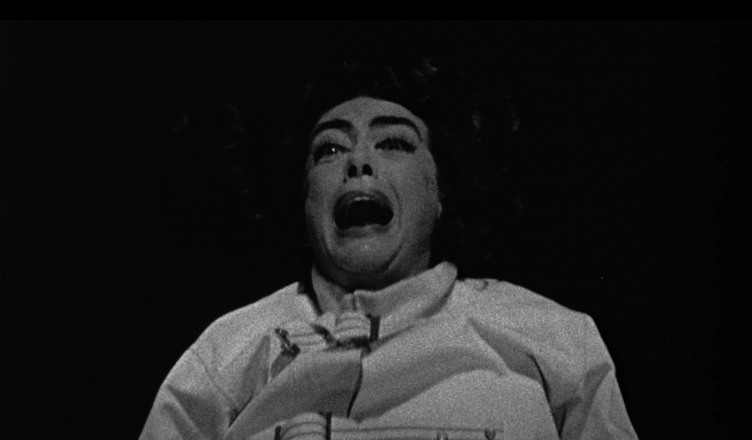Film Deets:
Director: William Castle
Screenplay: Robert Bloch
Actresses: Joan Crawford, Diane Baker
Category: Hagsploitation
Themes: Intergenerational Trauma, Mental Illness
Why do these screams matter?
In Strait-Jacket, Lucy Harpin (Joan Crawford) returns home from prison after being incarcerated for the brutal decapitation of her husband and his mistress; a murder witnessed by her young daughter, Carol (Diane Baker). When a rash of decapitations coincide with her return to the suburbs, Lucy becomes the prime suspect. A classic whodunit with not just murders but ax murders, this movie makes no bones about its Grand Guignol street cred. But it’s the film’s commitment to capturing the over-the-top reaction shots of its stars that give it the shot of campy exploitation that makes this movie a hagsploitation classic.
The film opens with a scream bookended by news clippings of the murder for which Lucy was incarcerated. It then morphs into Lucy’s screams as we see her commit the murders in the presence of her three-year-old daughter and then as she is confined to prison.
By hav ing Lucy’s scream introduce the film, the audience is being given some important clues about Lucy; namely that she is mentally unstable and full of rage. The pleas that are littered between her screams suggest a certain amount of fear but don’t do much to garner audience sympathy. Like the black and white news clippings that appear on screen, our understanding of Lucy’s motivations is similarly uncomplicated: she’s just the insane woman who beheaded two people with an ax while her young child watched.
ing Lucy’s scream introduce the film, the audience is being given some important clues about Lucy; namely that she is mentally unstable and full of rage. The pleas that are littered between her screams suggest a certain amount of fear but don’t do much to garner audience sympathy. Like the black and white news clippings that appear on screen, our understanding of Lucy’s motivations is similarly uncomplicated: she’s just the insane woman who beheaded two people with an ax while her young child watched.
To today’s audiences, these scenes and that scream probably come across as campy excess. But to original audiences, the framing of Lucy raised visibility of an invisible population. A closer look at pre-1960s politics and incarceration reveals the systemic invisibility of female prisoners. There exists no comprehensive data emanating from government studies on the intersection of women, crime, and incarceration because none was kept. Those statistics are only available for male prisoners. It wasn’t until feminism’s second wave in the 1960s that demands for more data concerning female prisoners entered mainstream conversations and it wasn’t until 1980 with the explosion of mass incarceration that data started being kept as part of regular operating procedures (Spindle).
With this history in mind, Strait-Jacket’s opening scream reads as an act of protest. While the audience is still asked to look at Lucy as unstable, her scream forces the audience to look at a system designed to silence women, particularly those labeled as difficult or threatening, a point underscored when the camera lingers on a newspaper clipping of Lucy in a literal straitjacket. Lucy’s screams are, in effect, her last chance to vocalize her feelings before being subsumed by an institutional structure designed to quiet her and women like her. They also constitute a transgressive moment in the context of a cultural attitude that grows even more dismissive of the emotional life of women as they grow older. Her decision not to accept her fate silently amplifies Lucy’s position as an unruly woman, and it is that framing that the film leverages to cast her as a potentially ongoing threat.
The film’s shocking revelation that Carol (the daughter) and not Lucy is responsible for the recent rash of killings suggests a surprisingly ahead-of-its-time understanding of the impact of intergenerational trauma and leads to another pivotal scream. In this scene, Carol’s screams reveal her as the murderer and showcase the complexity of her feelings toward her mother.
 Echoing her mother from the beginning of the film, Carol’s screams are a complicated hybrid of anger, madness, and grief that help to frame a popular convention with hagsploitation films: gaslighting. To gaslight someone is to make them question their own sanity and the audience realizes at this moment that this is exactly what Carol has been doing to Lucy throughout the entire film. But while the archetype of a younger woman gaslighting an older woman is certainly not exclusive to the horror genre, it does take on added resonance when paired with horror’s more transgressive tropes. It also advances a specifically conservative ideology that women have more to fear from other women than they do men. From the beginning of the film when a man’s voice selling newspapers covering Lucy’s trial gives way to Carol narrating the events leading up to Lucy’s incarceration, Carol is positioned as an authority on Lucy’s story. Carol’s youth and vitality are positioned in opposition to Lucy’s age and lethargy, and it is this framing that allows the former to manipulate the latter and the audience. We initially view Carol’s behavior toward Lucy as being that of a concerned daughter living in fear of the potentiality of her mother having another psychotic break. The film connects youth with vulnerability, an association made most clear when scenes of a wide-eyed Carol as a child morph into the present-day Carol. But the ending reveal that Carol is behind the new rash of violence reframes her actions to be premeditated and duplicitous. Carol cultivates a veneer of youthful innocence to avoid detection because she understands that Lucy’s age – a representation of her long journey with mental illness – makes her susceptible to community judgement.
Echoing her mother from the beginning of the film, Carol’s screams are a complicated hybrid of anger, madness, and grief that help to frame a popular convention with hagsploitation films: gaslighting. To gaslight someone is to make them question their own sanity and the audience realizes at this moment that this is exactly what Carol has been doing to Lucy throughout the entire film. But while the archetype of a younger woman gaslighting an older woman is certainly not exclusive to the horror genre, it does take on added resonance when paired with horror’s more transgressive tropes. It also advances a specifically conservative ideology that women have more to fear from other women than they do men. From the beginning of the film when a man’s voice selling newspapers covering Lucy’s trial gives way to Carol narrating the events leading up to Lucy’s incarceration, Carol is positioned as an authority on Lucy’s story. Carol’s youth and vitality are positioned in opposition to Lucy’s age and lethargy, and it is this framing that allows the former to manipulate the latter and the audience. We initially view Carol’s behavior toward Lucy as being that of a concerned daughter living in fear of the potentiality of her mother having another psychotic break. The film connects youth with vulnerability, an association made most clear when scenes of a wide-eyed Carol as a child morph into the present-day Carol. But the ending reveal that Carol is behind the new rash of violence reframes her actions to be premeditated and duplicitous. Carol cultivates a veneer of youthful innocence to avoid detection because she understands that Lucy’s age – a representation of her long journey with mental illness – makes her susceptible to community judgement.
But in Strait Jacket, Carol’s desire to gaslight Lucy is more a compulsive by-product of a traumatized mind than it is a calculated decision for personal gain. When this film was released in 1964, the general public was only just starting to understand the long-term impacts of experiencing trauma. And while the end of the decade and the early 1970s would see increased interest in how trauma, particularly divorce and parental separation, impacted children, the research was far from conclusive (Behere et al. 457). Carol’s screams and their vacillation between adult anger and childish desperation lay the blame for Carol’s murder spree at the feet of her mother, a blame Lucy seemingly takes when she announces her decision to spend the rest of her days trying to help Carol. As a child, Carol lacked a voice in what was happening to her family, but her screams reclaim that agency, even as they cast her as deranged. Her screams are a powerful reflection on how intergenerational trauma bonds women even as it simultaneously pits them against one another.
Works Cited
Behere, Aniruddh Prakash, Pravesh Basnet, and Pamela Campbell. “Effects of family structure on mental health of children: a preliminary study.” Indian Journal of Psychological Medicine, vol. 39, no. 4, 2017, pp. 457.
Spidle, Emily. “Invisible and Incarcerated: Women in a Male Dominated U.S Prison System.” 2017. Union College, Undergraduate Honors Thesis.
Strait-Jacket. Directed by William Castle, performances by Joan Crawford and Diane Baker, Columbia Pictures, 1964.






